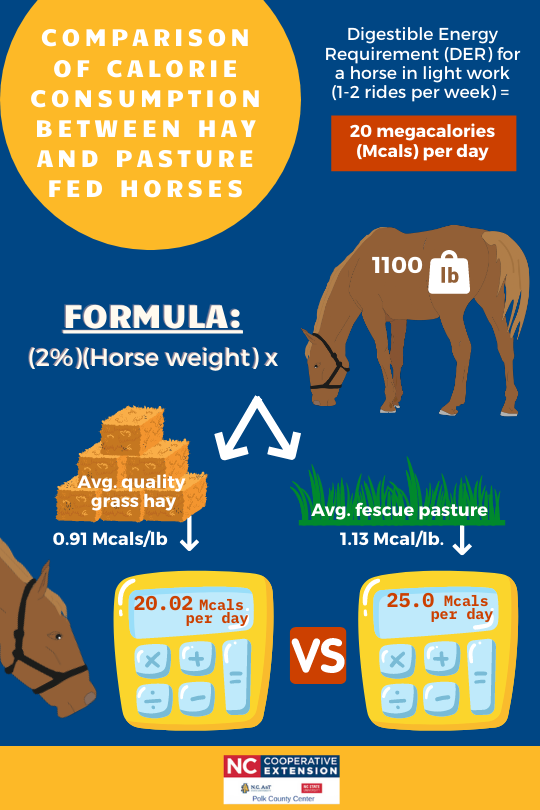Equine Calorie Consumption: Hay vs Pasture Grazing
go.ncsu.edu/readext?778223
en Español / em Português
El inglés es el idioma de control de esta página. En la medida en que haya algún conflicto entre la traducción al inglés y la traducción, el inglés prevalece.
Al hacer clic en el enlace de traducción se activa un servicio de traducción gratuito para convertir la página al español. Al igual que con cualquier traducción por Internet, la conversión no es sensible al contexto y puede que no traduzca el texto en su significado original. NC State Extension no garantiza la exactitud del texto traducido. Por favor, tenga en cuenta que algunas aplicaciones y/o servicios pueden no funcionar como se espera cuando se traducen.
Português
Inglês é o idioma de controle desta página. Na medida que haja algum conflito entre o texto original em Inglês e a tradução, o Inglês prevalece.
Ao clicar no link de tradução, um serviço gratuito de tradução será ativado para converter a página para o Português. Como em qualquer tradução pela internet, a conversão não é sensivel ao contexto e pode não ocorrer a tradução para o significado orginal. O serviço de Extensão da Carolina do Norte (NC State Extension) não garante a exatidão do texto traduzido. Por favor, observe que algumas funções ou serviços podem não funcionar como esperado após a tradução.
English
English is the controlling language of this page. To the extent there is any conflict between the English text and the translation, English controls.
Clicking on the translation link activates a free translation service to convert the page to Spanish. As with any Internet translation, the conversion is not context-sensitive and may not translate the text to its original meaning. NC State Extension does not guarantee the accuracy of the translated text. Please note that some applications and/or services may not function as expected when translated.
Collapse ▲The N.C. Cooperative Extension of Polk County office held a field day last Tuesday, February 23, 2021, which was graciously hosted by two of our Extension Advisory Council members, Terry and Jane Lynch, at their farm near Columbus. In the equine/pasture management session, I discussed how to manage our horses’ calorie consumption as they transition from a mostly hay diet this winter to an abundance of fresh spring pasture. If you enjoy math, here’s an example to follow that shows the big jump in calorie consumption once our horses start grazing more fresh forage:
For this example, I utilized the digestible energy requirement (DE, Mcals) for a horse in light work (1-3 rides per week) listed in the NRC Nutrient Requirements of Horses, which is 20 megacalories (Mcals) per day. If an average-sized horse weighing about 1100 pounds consumed 2% of his bodyweight per day in dry matter of an average quality grass hay (0.91 Mcals/lb. from Equi-Analytical’s online database), he would consume 20.02 Mcals per day, which is enough to meet his entire daily energy requirement. In most all cases, fresh forage from pasture is higher in energy (i.e., calories) than stored hay, but how can we estimate how many calories our horses are consuming while at pasture? If your horses have free access to pasture, they can consume between 2-2.5% of their bodyweight per day. Previously sampled fescue from a North Carolina pasture in April had an energy density of 1.13 Mcal/lb. The same horse in light work grazing about 22 pounds of dry matter from this pasture would consume approximately 25 Mcals per day- 5 extra Mcals than his daily requirement.

For comparison purposes, a growing two-year-old in a training program has a daily requirement of 24.8 Mcals/day. This excess in calorie consumption is enough for this horse to gain a full body condition score in about 2.5 months, and even quicker for a horse that is rarely ridden. Horses that are overweight carry a higher incidence of metabolic diseases such as insulin resistance, laminitis, and cushings, so it’s important to monitor changes in their weight over time. Restricting time at pasture, grazing muzzles, and feeding a lower calorie hay before turnout to prevent gorging are all options to manage our horses’ calorie consumption; however, some horses learn to manipulate whichever system you choose.
Research has demonstrated that some horses learn the turnout routine and speed up their consumption rate while at pasture. Others skillfully master the art of placing the grazing muzzle directly down on top of bunch grasses, such as fescue, to reduce the muzzle’s effect. Try different management techniques to see what works best for you and your horses. If you’re not tired of all the math so far, there’s even a formula developed by researchers at NC State University that we can use to estimate the number of calories your horse consumes based on the number of hours he spends grazing. Feel free to contact me to discuss options specific to your horse and management style.




